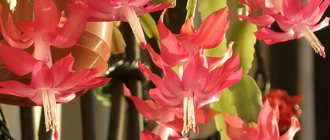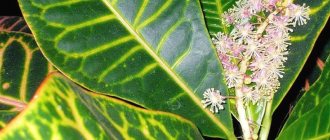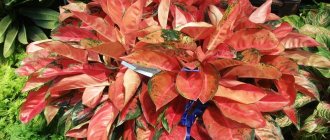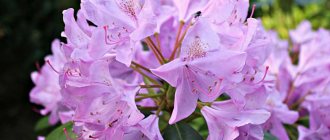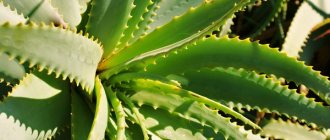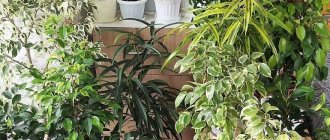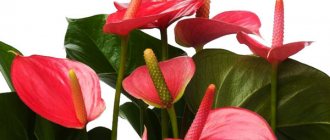Aglaonema is another species of tropical representatives that are very popular with professional flower growers and indoor plant lovers. It came into home collections relatively recently, about 60 years ago. In this article I would like to introduce you to this unusual plant, the diversity of its species, the intricacies of care and propagation.
A little about the plant
Aglaonema belongs to the Araceae family. In nature, this plant is found in the tropical forests of India, China, New Guinea and Asia. It can also be found on the banks of streams or rivers, in swampy areas and on wet plains. It is grown as a beautiful decorative foliage plant.
- It grows in the form of a beautiful, evergreen bush. It can grow a little more than 1 m in height. It begins to branch from the base; over the years, a small trunk is formed, on which traces of dried leaves are visible.
- The leaves are dense, leathery, oblong with different colors, which depend on the type of plant.
- The inflorescence is a spadix with a light, yellow-green veil, which in its shape resembles a spadix, like that of Spaciphyllum. Depending on the species, the cobs can be thin or thick. The fruits take a long time to ripen, more than six months.
It is believed that aglaonema moisturizes and purifies indoor air from streptococcal and other pathogenic bacteria.
| IMPORTANT Remember that aglaonema juice and berries are poisonous to humans! Wear gloves when working with the plant. Keep children away from the plant. |
Aglaonema description
Aglaonema is an evergreen subshrub that belongs to the large family of Aronicaceae or Araceae plants. The aroid species of evergreen grasses and subshrubs is common in Southeast Asia. It was from there that aglaonema spread throughout Europe. The family belongs to the class of monocotyledonous eukaryotes; the genus includes more than 50 species.
About 200 hybrids have been selected through selection, differing from each other in shape, developmental characteristics or content. "Aglaonema" - this name is formed as a result of the merger of two Greek roots. In translation, the stems mean the phrase “bright thread”.
The name characterizes the external description of the plant. The flower has a strong vertical stem with dense leathery leaves, which, as they grow, take on a pointed lanceolate shape. The length can vary from 9 to 16 cm.
Aglaonema, the species of which are diverse, produces leaves of different shades. Color depends on the variety. The plates are painted in various colors: from dark olive to pink-yellow. This feature makes the plant a popular decorative flower. Varieties can be distinguished by a variety of amateur photos. Aglaonema is similar to indoor Dieffenbachia, but, unlike it, it boasts unexpected colors.
The advantage of the genus is the unusual flowering, which lasts for several months. Corn cob-shaped inflorescences gradually form in the axils. They are covered with a pale green base. The base falls off after a while, revealing a pale green or milky white flower.
The shapes of the inflorescences are elongated, forming a regular semi-oval, or cylindrical, reaching 6 cm in length. After flowering, reddish fruits appear in place of the inflorescences. Reproduction is carried out using seeds from berries. Despite the fact that they give the plant an attractive appearance, the reddish berries are poisonous.
Attention! Fruit juice is strictly prohibited for consumption.
Types and varieties of Aglaonem
There are about 50 species of Aglaonema and more than 200 hybrid varieties. The most common and beautiful varieties of Aglaonema are described below.
Aglaonema modesta (moderate)
In nature, it grows in China and the surrounding area. Has several subspecies. The leaf blade can be painted a solid green color or be variegated. It grows up to 50 cm in height. The leaves are wide, pointed, glossy and slightly wavy at the edges. The fruits are bright red. It is considered the most unpretentious species.
It grows well even in the dark corners of our houses, but it is better if it is a bright room - constant stress from lack of light will affect the general condition of the plant and the beauty of the leaves.
Photo: Aglaonema modestum
Aglaonema variablea (variable)
Found naturally in the Philippines. The leaves are elongated, greenish with green or silver veins, depending on the species, located on dense and tall stalks. The length of the leaf can be up to 30 cm and the width up to 10 cm. The edge of the leaf is slightly wavy. It can grow up to 1 m in height. Up to 5 flower stalks can form on one plant, reaching a height of 20 cm.
Photo: Aglaonema commutatum
Silver Queen
The most common hybrid variety of Aglaonema changeable (Silver Queen).
The leaf plate is colored silver-green with green veins located throughout the leaf. In the southern regions, where there are no sub-zero temperatures in winter, this variety is grown outdoors as a garden flower.
The variety is very unpretentious and is suitable for cultivation by beginning flower growers, as well as those who want to get acquainted with this plant for the first time and get a positive result and experience. Blooms every year, under the right conditions.
Photo: Silver Queen variety
Silver King
Also quite common is the hybrid variety of Aglaonema changeable Silver King. Not only its leaf blades are painted silver, but the entire base of the petioles. It turns out to be a very delicate bush.
Photo: Silver King variety
Aglaonema Round
Low-growing appearance. The leaves are heart-shaped. Painted dark green with thin veins. The color of the veins depends on the variety. They can be white, pale pink, crimson. Thanks to these veins, the plant looks very gentle and creates a romantic atmosphere.
Photo: rounded aglaonema (Aglaonema rotundum)
Short-vegetated Aglaonema
The main difference between this type of Aglaonema and others is that it does not have stems. It is in the ground, and green, elongated and pointed leaves immediately begin to grow from the ground. Along the central vein of the platinum sheet there is a white, thin, contrasting stripe.
Thanks to these properties, the plant grows as a very lush and compact bush. This plant will look ideal in interiors where there are white stripes or spots, as well as in the nursery, bedroom and kitchen.
Photo: Aglaonema Brevispathum
Painted Aglaonema
It forms very lush bushes, up to 60 cm high. The bush branches quite strongly in the lower part, forming many new shoots. The leaves are elongated, with pointed ends, and can grow up to 20 cm in length. The ripe fruits are red, inedible, like all fruits of other Aglaonema species.
The color is spotted, reminiscent of a khaki print. Shapeless spots can be whitish-cream and greenish-gray and blue, distributed in a chaotic manner over the entire surface.
If you squint at this plant, the background color will appear bluish-silver. There are both two-color and three-color colors, depending on the variety.
Photo: Aglaonema pictum
Aglaonema splendor
It grows up to 1 meter in height. The leaves are large, dense and shiny, colored green. The shape of the leaf blade is oval, it can reach up to 40 cm in length and up to 20 cm in width. The length of the cob flower is about 6 cm. The trunk is dense and stable, and becomes bare from below over time.
Photo: shiny aglaonema (Aglaonema nitidum)
Aglaonema Crete
It can reach a height of 70 cm. The leaves are oblong, with a pointed tip and very bright, variegated colors. The leaf grows up to 15 cm in length. If you touch the central vein with your hands, you can feel that it is pressed into the leaf and protrudes from the back side.
It is valued by flower growers for its attractive colors. When examining the leaves, you can count several green and red shades.
Photo: Aglaonema Crete
Cutless
Hybrid variety "Cutlass". The leaves are elongated and narrow. A very impressive and compact plant, suitable for any interior: from an office to a country house. Leaf platinum is painted in a silvery-greenish color with dark green splashes along the perimeter of the sheet. Loves good lighting and a warm atmosphere.
Photo: aglaonema Katlees, or Kutlass
Friedman
Painted Aglaonema, variety Freedman. It can grow up to 1 m in height. The leaves are quite wide with a ribbed surface, on a high and dense stem. The platinum sheet is painted in a soft green hue with small green splashes throughout the surface.
Grows very well in home greenhouses and large pots. Easy to care for, it is best to grow in a bright room, without access to direct sunlight. It can also grow in a dark corner.
Photo: Aglaonema Friedman
Planting and growing a flower
It is not recommended to immediately replant a houseplant aglaonema purchased in a store. Let it adapt within 2-3 weeks.
Landing rules:
- Place drainage in the pot - expanded clay, small pebbles, broken shards or nut shells;
- Fill the soil up to 1/2 volume;
- Place the flower in the center of the pot, straighten the roots, add substrate;
- If the plant is young, then there is no need to deepen it, but an adult plant can be planted a little;
- Generously water the crop with warm water.
What can be done to make the flower grow lush and beautiful? You need to know its features:
- The tropical bush loves places with diffused light, as well as slightly shaded ones. Protect it from direct sunlight and do not place it near heating appliances;
- In summer, the temperature should be + 20-25 degrees, in winter – slightly lower;
- The flower prefers warmth and high humidity, so water it twice a week, and especially take this into account in dry weather;
- The culture does not tolerate drafts and does not like to come into contact with tobacco and other smoke.
The subtleties of growing aglaonema at home
At home, different types and varieties of aglaonema feel great, often bloom and bear fruit.
Temperature
Loves moderate temperatures, in summer from +20 to +26 °C, and in winter from +16 to +20 °C. Try to avoid sudden temperature changes. In the summer, it is best to take the plant outside, to a shady place or to a greenhouse. But before that, harden off the plant and make sure there will be no more frosts.
She doesn't like drafts either. Cold air entering the plant in winter is especially dangerous. The cold may cause the roots to freeze and then begin to rot.
Light
They like partial shade or bright, diffused light, depending on the species. In nature, Aglaonemas grow in the lower layer of the tropical forest, where little light reaches. Therefore, they all tolerate shading and partial shade well. But variegated species are better placed in a well-lit place, without direct sunlight on the leaves of the plant. This way the color will be as attractive as possible, and the sun will not cause burns on the leaves.
- Variegated species love bright lighting, without direct sunlight,
- Species with a single color are best placed in the shade.
Watering and humidity
You need to water with “soft” water - rain, snow or settled water. But do not overdo it with watering, since overwatering is just as destructive for Aglaonema as completely drying out the earthen clod.
- In the summer, you need to water frequently and abundantly so that the substrate is always moist.
- In winter, we reduce watering, but make sure that the soil does not dry out.
Loves strong air humidity. Dry air has a bad effect on the development of the plant; when the leaves unfold, they do not have sufficient moisture and, as they unwind, they become deformed and lose their attractive appearance. Also, the edges of the leaves may dry out.
- Frequent spraying and bathing in the shower have a beneficial effect. In winter, it is advisable to spray and bathe with warm water.
- You can also place a bowl of water next to the plant, which will provide additional evaporation of moisture, especially if the plant is on a windowsill or near a radiator.
- Or place the pot itself on a tray with damp expanded clay, moss or pebbles, while making sure that the pot is not in water.
Top dressing
Responds well to fertilizing with universal flower fertilizers. Fertilizers need to be applied every 2 weeks from March to August. The rest of the time, the plant begins a period of rest, it slows down in growth and does not need feeding.
Planting and transplanting
Young plants need to be replanted every spring into a slightly larger pot with a new nutrient substrate. This way they grow and develop much more actively. Mature plants can be replanted or transplanted every 2 to 4 years, depending on need.
The substrate for Aglaonema is easy to make yourself; it must be nutritious and air and moisture permeable:
- You need to take 3 parts of leaf or garden soil, 1 part of peat, 1 part of washed river sand and 0.5 part of crushed charcoal. Mix all this thoroughly.
- Be sure to place drainage at the bottom of the pot, at least 5 cm. Expanded clay, fine gravel, pebbles, and polystyrene foam broken into small pieces can be used as drainage.
Aglaonema grows very quickly in hydroponics.
Aglaonema - signs and superstitions
Some people are afraid to keep aglaonema in the house because of its toxicity. This is fundamentally wrong. After all, the plant does more good than harm. In addition, keeping a bush in the house is considered a good omen.
For welfare
In Asia, where aglaonema comes from, there are whole legends about this flower. A particularly widespread story is that of one man who saw numbers in drops of dew on a plant. I entered them into a lottery ticket and won a mind-boggling amount of money. Since then, it is believed that this bush brings good luck to the house.
Species with white stripes and light green spots on the leaves will help improve the financial condition of household members.
If you saw aglaonema in a dream, this is good. Your cherished dream will come true, and you will achieve all your goals in life.
In an office next to the workplace, a plant will help charge the atmosphere with positive energy, collect thoughts and solve all the tasks set by the boss. And the bosses, in turn, will immediately pay attention to the executive employee and offer a promotion.
According to popular beliefs, thieves cannot enter a home where aglaonema grows.
Care problems
- Deformed leaves and dry edges: little humidity in the air or insufficient watering of the plant.
- The leaves are curled and dry at the edges: exposure to cold air or frequent drafts.
- There are whitish spots on the leaves: sunburn. Urgently move the plant to another place where there is no direct sunlight. Let it stand there for a while and “go away”, and then spray with warm water and water.
- Slow plant growth: Watering with “hard”, unsettled or cold water. To reduce the hardness of water, you can add a little citric acid to it, literally at the tip of a knife.
Pests of Aglaonema:
- spider mite,
- aphid,
- thrips,
- whitefly
If you find any of the representatives, immediately treat the plant with folk remedies or ready-made preparations from the store. Of course, using traditional methods will be more environmentally friendly and healthier for you and the plant. At first I use only them, and if it doesn’t help, only then use chemistry.
But, as a rule, traditional methods always work 100%, the only thing is that you have to process the plant several times, but we do not harm nature.
Difficulties in growing
High air humidity combined with high temperature are not only optimal conditions for the life of flowers such as Aglaonema. In such conditions, active growth and reproduction of fungi, which are malicious plant pests, begins. The flower is most often affected by leaf spot and gray rot. You can get rid of fungal diseases using fungicides.
In addition, the tropical flower is also favored by common pests of indoor plants - thrips, aphids, scale insects, as well as spider mites. They get rid of them using standard methods - using suitable chemicals.
How to propagate
There are several ways to propagate Aglaonema:
- seeds,
- you can cut off the apical shoot and root the cutting,
- break off the grown offspring (shoot),
- or divide the rhizome when transplanting.
It is best to propagate in the spring, but it can also be propagated in the summer until July.
Reproduction by apical shoot (cuttings)
In the spring we choose an escape. With age, Aglaonema becomes elongated, the lower part of the trunk becomes bare and looks unsightly - it requires rejuvenation. Also, the trunk itself can collapse and eventually break completely. These are the shoots that should be chosen first for cuttings.
- It can be torn off with clean hands, but it is best to cut it off with a sharp, disinfected knife, pruning shears, or scissors.
- It is best to cut off the shoot closer to the surface of the earth, leaving a stump on the mother plant 2–3 cm long.
- If the shoot is long, then it can be divided into several cuttings. Each cutting can be made 10 - 18 cm.
- Using your hands, carefully tear off the lower leaves at the base of each cutting. You can cut them off with the sharp tips of garden shears.
- It is advisable to dip the lower tip of the cutting a little in a preparation for root formation (kornevin).
Rooting in water
Then the cutting can be placed in water. Water should cover the lower part no more than 5 cm.
Cuttings with roots can be planted several pieces in 1 pot. This way the plant will look more attractive and you will quickly get a ready-made lush Aglaonema bush.
Rooting in soil
Or you can immediately plant it in prepared, pre-watered soil. We immerse the cutting in the ground to half its length. Water again and lightly press the soil on top with your fingers; if necessary, add a little soil to the pot.
- We put a plastic bag on top of the plant or cover it with a plastic container to get a greenhouse effect. This will allow the plant to take root faster.
- We ventilate the plant periodically, for 15-20 minutes a day, so that drops of condensation do not over-moisten the substrate and accumulate on the leaves.
- Place in a warm place, out of direct sunlight.
Make sure that the soil during rooting is not too wet and does not cause putrefactive processes. It is necessary to water moderately, only as the top layer dries.
When you notice that the plant has begun to grow, and this happens usually after 2 weeks in spring and summer and about a month in winter. New leaves will begin to appear, and the plant itself will look stronger; we clean the greenhouse and care for it as usual.
Propagation by seeds
This is also a very effective method of propagation, given that Aglaonema readily blooms and bears fruit at home and does not require artificial pollination.
You need to wait until the red berry is completely ripe on the bush. Determining the ripeness of the fruit is quite easy - when touched, the berry should fall into your hand on its own.
Our seeds always have 100% germination, tested repeatedly. Seed germination is especially good in the first year.
Sowing
- We separate the seeds from the pulp and plant them in a loose, nutritious substrate to a depth of 1–2 cm.
- We do not compact the earth on top, but leave it as loose as possible.
- We water by spraying so that the seeds do not get buried and germinate evenly.
- Cover the top with glass or plastic wrap. Place in a warm, bright place.
- When we see that the first shoots have sprouted, we immediately remove the covering material.
We water by spraying from a spray bottle until the seedlings become stronger and require planting into separate pots.
Diseases and pests
Aglaonema is resistant to infections. However, improper care at home can cause the flower to become infected.
The plant is characterized by the following problems:
- Spider mite. The pest settles under the leaves, forming a thin web. The tick is dangerous because it drinks the sap of the plant. You can get rid of mites by treating the flower with insecticides, in other words, chemicals, or by pouring hot water over it for two minutes.
- The appearance of gray rot . The disease appears on the leaves of aglaonema in the form of gray spots that are soft to the touch. A solution of copper sulfate will help remove rot, as well as removing the affected parts of the flower.
- Root rot . The cause may be excessive watering, low temperature and cold water. The problem can be solved by the following steps: increase the temperature, reduce watering, remove affected roots, water the plant only with warm water.
- Aphid attack . If you notice that the leaves have begun to curl, then most likely the aglaonema is being attacked by aphids. Usually this pest does not hide, but forms its colonies on the underside of the leaf. To get rid of aphids you need to acquire the following drugs: Lannat or Aktara. You can use folk remedies, for example, spraying the plant with an infusion of garlic or onion.
- Rust formation . This is a kind of fungus that affects the leaves of aglaonema with orange growths that are soft to the touch. The upper part of the leaf is covered with golden spots. In this case, the diseased leaves are cut off, and the bush is completely treated with young sulfur.
- When caring for aglaonema at home, you can see sooty fungus or black fungus on the leaves of the flower . When a disease attacks a plant, it affects the leaves, forming a film on them. Afterwards, fungal spores appear in the form of droplets on the leaves. This plaque clogs the pores of the plant, preventing photosynthesis and respiration of the flower. To solve the problem, use insecticides, rinse the plant with warm water, and wipe the leaves with a cotton swab.
- Feltworts or pseudocushions . Pests attack the leaves, deforming them, causing them to dry out and crumble. Finding an unexpected guest is not difficult; he settles on the stems and leaves of aglaonema. In appearance it looks like a lump of cotton wool. Such drugs as Fazol or Fitoverm are effective in killing parasites.
- Whitefly . This insect looks like a moth. Its length is 2-4 mm. The larvae settle on the underside of the leaf and feed on the sap of the flower. For treatment, use the insecticide Actellik (one ampoule per liter of water).
- Thrips . Small insects that feed on plant sap. First, stripes and spots of white and silver appear on the leaves. Afterwards, the tissue in the pest’s habitat dies. To solve the problem, insecticides are used: Fitoverm, Karate, Actellik, Karbofos. You can also rinse the plant under a warm shower.
Earth mixture
The soil mixture for aglaonema must be nutritious, air- and water-permeable.
Mixture No. 1. Leaf soil, humus, peat, sand (1:1:2:1) with the addition of a small amount of charcoal.
Mixture No. 2. Leaf soil, coniferous soil, humus, peat, sand (1: 1: 1: 2: 1).
Mixture No. 3: Leaf soil, peat, turf soil, sand (2:1:1:1).
Mixture No. 4: Leaf soil, turf soil, peat, sand (1:1:1:2).
Instead of sand, you can use perlite. At the bottom of the pot, do not forget to place a high, up to 5 centimeters, drainage made of expanded clay or pebbles.
Bloom
Aglaonema - home care, how aglaonema blooms
The plant rarely blooms. This can only be achieved with careful care. The flowers are quite small, especially against the background of the large leaves of the plant. After flowering, small red berries may appear, which should not be touched as they are poisonous.
At home, aglaonema can bloom
Useful tips for growing
Simple recommendations from experts will help novice gardeners avoid many problems when growing Aglaonema fickle:
- the plant is undemanding in terms of temperature and lighting, but has an extremely negative attitude towards lack of moisture, so it must be provided with a comfortable level of humidity;
- regular spraying of the foliage of the flower during the hot period will create conditions closer to the natural habitat of the perennial, and will also give the crown brightness, juiciness and shine;
- the frequency of fertilizing the crop will be largely determined by the size of the container: the smaller the pot, the more often fertilizer should be applied;
- It is strictly forbidden to allow sudden temperature changes in the room with the flower and the presence of cold drafts;
- Aglaonema has a very negative attitude towards tobacco smoke and instantly reacts to it by wilting its leaves.
The amazing beauty of Aglaonema variable can become an original decoration for a home or office interior. It is undemanding in care, not capricious, and is able to grow and develop in partial shade. By following simple rules of agricultural technology, you can easily and effortlessly get a lush, aesthetically attractive bush with large leaves of unusual colors.
Watering
Water the aglaonema with settled or boiled warm water, generously from spring to autumn, moderately in winter. Before watering, be sure to check whether the top layer of soil in the pot is dry. Aglaonema cannot tolerate stagnant water. Wet, non-drying soil in a pot at low air temperatures can affect the appearance of the plant and the condition of the root system - it will rot.
To determine whether a plant needs watering, simply tap the pot. If the soil in the pot is damp, the sound will be dull; the drier the soil, the louder the sound.
How to grow aglaonema. Reproduction methods
In its native habitat, aglaonema reproduces by root shoots or by self-seeding. In indoor conditions, the plant is usually propagated vegetatively, since this method makes it possible to best preserve the species differences of the mother crop.
Reproduction by division
This is the easiest way to propagate a flower. When the plant is replanted, its rhizome must be thoroughly cleaned of soil. This is necessary to examine the lateral processes with leaf primordia. Cut them carefully and plant them in a separate pot. This method of reproduction does not harm the donor aglaonema.
Reproduction by cuttings
This propagation method involves cutting the top cuttings, which are then planted vertically in loose soil. You can also take cuttings that grow from the bottom of the stem, but they must be planted horizontally, gently pressing the nodes down into the soil with your fingers. Planted cuttings love warmth and light. With proper maintenance and care, you will notice the first shoots within a couple of weeks.
Growing by seeds
The collected seeds should lie in a dry place for about six months, only then they can be planted. Take a container with well-moistened and loose soil, plant the seeds in the spring and cover the ground with polyethylene. Ventilate and water the plant periodically. Young shoots will appear after half a month or a month, and then they can be planted in separate pots.
Transfer
The plant does not tolerate the replanting process very well, so this should be done extremely rarely (no more than once every 4-5 years), when the old pot becomes too cramped. The optimal period for transplantation is spring. But the bottom of the new container you have chosen needs to be filled with small brick fragments or, for example, pebbles. Do not forget that the soil must be airy. And don’t get carried away with cleaning the roots from the soil, so as not to damage them. If damage still cannot be avoided, carefully cut it off after treating the instrument with an antiseptic.
To ensure that aglaonema foliage grows fluffy, thick and beautiful, remove the top part of the bush when replanting. Such actions will help the culture not to slow down its growth. It is advisable to sprinkle the cut area with charcoal or a special growth stimulating mixture.
Soil and pot for the plant
In order for a flower to grow healthy and attractive, it is necessary to have nutritious soil. The soil should have good water and air permeability and be loose. If you prepare the soil yourself, then in composition it should consist of: three parts of leaf soil, one part of peat, one part of sand, as well as 1/2 part of charcoal and 1/2 part of humus. You can buy ready-made soil for heather, azaleas or violets. This composition is perfect for our “green friend”.
The root system of the plant is fibrous and superficial, so it does not need a deep pot. An indoor flower has excellent leaf growth and better development is possible if its roots grow in a small container. The ideal option would be a wide (if there are young shoots) and shallow pot, but do not forget that 1/4 of its height must be filled with drainage.
